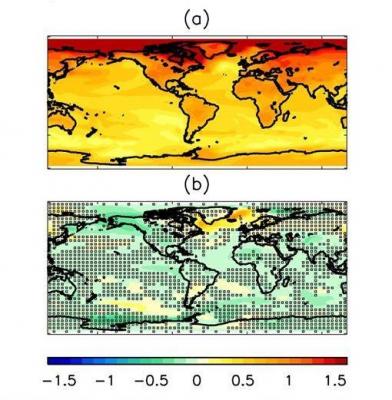Decadal Climate Prediction: An Update from the Trenches
Decadal Climate Prediction, An Update from the Trenches: The new and rapidly evolving field of decadal climate prediction, using initialized climate models to produce time-evolving predictions of regional climate, is producing new results for predictions, predictability, and prediction skill for the next few decades. Decadal climate predictions are of interest not only for potential users of such near-term climate change information, but also for improving our understanding of processes in the climate system. Recent multi-model results suggest that there is relatively more decadal predictive skill in the North Atlantic, western Pacific, and Indian Oceans than in other regions of the world oceans. Aspects of decadal variability of sea surface temperatures (SSTs), like the mid-1970s shift in the Pacific, the mid-1990s shift in the northern North Atlantic and western Pacific, and the early-2000s hiatus, are better represented in initialized hindcasts compared to uninitialized simulations. There is evidence of statistically reliable predictions of surface temperature over various land and ocean regions for lead times of up to 6-9 years. As in the early days of El Niño-Southern Oscillation (ENSO) prediction, improvements to models will reduce the need for bias adjustment, and increase the reliability, and thus usefulness, of decadal climate predictions in the future.
The importance of improved information about near-term (from one year to several decades in advance) regional climate for many societal applications has prompted considerable research in the field of decadal climate prediction that addresses those timescales. This paper provides scientists and possible users of such near-term climate information with an update of research in this rapidly evolving field. Recent multi-model results suggest that there is relatively more decadal predictive skill in the North Atlantic, western Pacific, and Indian Oceans than in other regions of the world oceans. Aspects of decadal variability of SSTs, like the mid-1970s shift in the Pacific, the mid-1990s shift in the northern North Atlantic and western Pacific, and the early-2000s hiatus, are better represented in hindcasts initialized with observations compared to uninitialized simulations. For the first five or so years of a decadal prediction, skill could come from the initial state, and after that skill arises due to the external forcing, with some regions having potentially greater skill than others. Further quantification with variables other than surface temperature needs to be done and applied in reliability studies, which are just now beginning, in order to demonstrate usefulness of decadal climate predictions.

